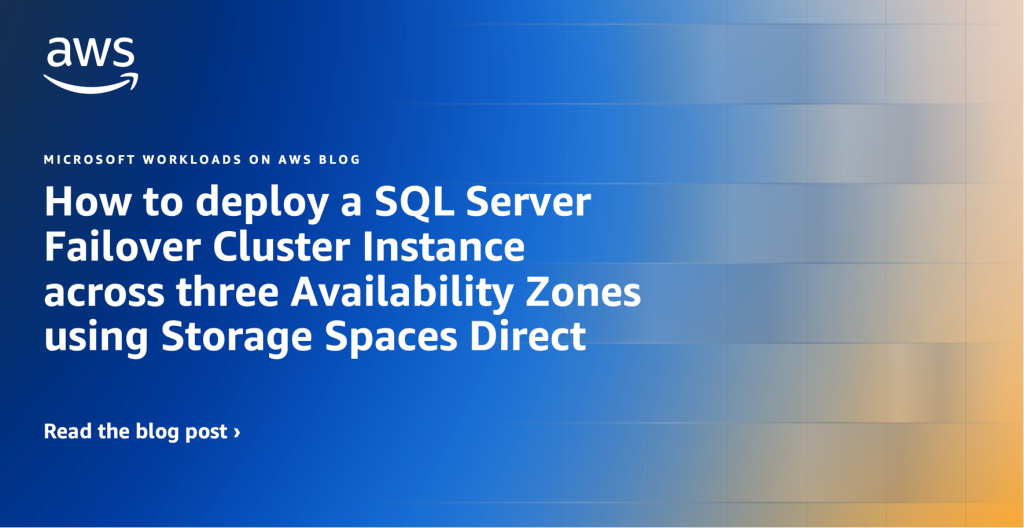Microsoft Workloads on AWS
Category: Storage
Mastering SQL Server Backups with T-SQL Snapshots and Amazon FSx for NetApp ONTAP
In this blog post, we will guide you through the process on performing a snapshot backup using native T-SQL based backup abilities and snapshot technology of Amazon FSx for NetApp ONTAP (FSxN). This method provide near-instant, consistent backups with negligible I/O, storage and compute capacity impact unlike traditional Microsoft SQL Server backups. Introduction Microsoft SQL […]
How to deploy a SQL Server Failover Cluster Instance across three Availability Zones using Storage Spaces Direct
In this blog, we’ll demonstrate how to architect and implement a high-availability Windows Server Failover Cluster (WSFC) with SQL Server using Amazon Elastic Compute Cloud (Amazon EC2) and Amazon Elastic Block Storage (Amazon EBS) across three Availability Zones (AZs). This approach transcends the traditional two-AZ limitations of Amazon FSx and one-AZ limitation of EBS multi-attach. […]
Deploy SQL Server Container Clusters using Amazon EKS and Amazon FSx for Windows
Introduction This blog post shows how to deploy a highly available SQL Server instance in a container using Amazon Elastic Kubernetes Service (Amazon EKS) with persistent storage backed by Amazon FSx for Windows File Server. Running databases and other stateful workloads in containers has grown significantly over the years. According to the CNCF Annual Survey […]
How to use persistent storage with AWS Elastic Beanstalk Windows deployment.
Introduction This blog post demonstrates how to use Amazon FSx for Windows File Server(FSxW) as persistent SMB storage for Windows applications running on AWS Elastic Beanstalk. The solution addresses common challenges with configuring persistent storage and enables direct access to SMB shares within AWS Elastic Beanstalk Windows environments while maintaining application performance, flexibility, and security […]
Automating SQL Server Point-in-Time Recovery Using EBS Snapshots
This blog post introduces a new AWS feature that enables point-in-time recovery for SQL Server using EBS snapshots. It offers a detailed walkthrough for creating VSS-integrated snapshots and restoring SQL Server databases using EBS snapshots to simplify database backups and automate point-in-time restore. Introduction Amazon Web Services (AWS) recently introduced support for restoring Microsoft SQL […]
Harness Amazon Q Business power with Amazon FSx file server for enterprise search.
Introduction In today’s business landscape, organizations look for ways to extract insights from their growing data assets and rely on their file server infrastructure to store, manage, and share critical data. The volume and complexity of data creates challenges to maximize its value. Companies need a new strategy to overcome these obstacles. Amazon Q Business […]
Running SQL Server Stretch Failover Cluster Instance on Amazon EC2
In this blog post, we explore how to implement Microsoft SQL Server Failover Cluster Instance (FCI) on Stretch Cluster Replication in Amazon Elastic Compute Cloud (EC2). We are going to use Amazon Elastic Block Store (EBS) Multi-Attach on io2 volumes with Microsoft Windows Server Storage Replica technology as a shared storage solution across Availability Zones […]
Ola Hallengren’s SQL Server Maintenance Solution in AWS
In this blog, we will demonstrate using Ola Hallengren’s SQL Server Maintenance Solution with native backups to Amazon S3. A common task for customers is to configure database backups and maintenance jobs for their SQL Servers. Ola Hallengren’s SQL Server Maintenance Solution scripts can simplify this task by automating SQL Server database backup and maintenance […]
Hybrid Active Directory: Disaster recovery, cyber resiliency, and high availability solutions on AWS
In this blog post, we will present comprehensive strategies and techniques to strengthen disaster recovery and bolster cyber resilience in hybrid Microsoft Active Directory (AD) environments running in the AWS Cloud by leveraging AWS Elastic Disaster Recovery (AWS DRS) , AWS Backup, and solutions for extending AD onto Amazon Elastic Compute Cloud (Amazon EC2) instances. […]
Automated user creation and provisioning in Active Directory and Amazon WorkSpaces
For customers that have workloads in the AWS Cloud, a common use case is the provisioning of new user accounts in Active Directory, and subsequently, WorkSpaces for these new users. In this blog post, we will present an efficient and reusable solution to automate the creation, provisioning, and deprovisioning of Microsoft Active Directory (AD) user […]









